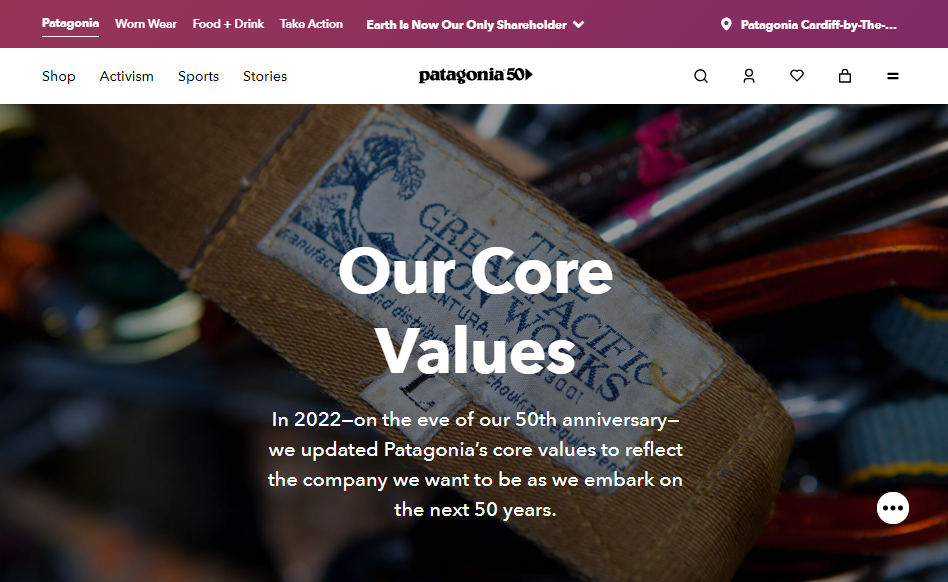Nearly all businesses have a mission, vision, and values statement, but how many do so just to check a box rather than drive the company forward?
More than just a north star for the company, strategic and actionable mission, vision, and values statements become powerful tools for shaping and communicating your organization’s unique brand story and fostering brand loyalty. And in an era where consumer trust is hard to come by, it’s one investment that could deliver big returns.
Start creating your own statements today with our free Mission, Vision, and Values Template.
As a client-first creative communications agency, the team at Farinella has built a 30-year track record of delivering brand storytelling that inspires connection and drives business. Experts in crafting these essential business statements, we help companies stand out with creative solutions that move the needle.
In this practical guide, we break down the importance of mission, vision, and values statements and provide best practices for creating mission vision and value statements. There is no fluff here, just actionable insights and examples you can use to elevate your business.
Why mission, vision, and values statements matter
As the foundation for your organization’s strategic plan, your mission, vision, and values statements become the compass guiding your brand’s journey. These statements provide a clear sense of purpose and direction for your company’s future while inspiring your team and stakeholders.
Beyond that, they create a consistent brand identity, instill a sense of belonging, and help the brand connect with its audience on a deeper level.
Where many organizations fail is aiming for aspirational statements rather than actionable ones. When your statements are actionable, they become practical roadmaps that guide your organization’s daily operations, strategic decisions, and stakeholder interactions. They become powerful tools for organizational success and transformation when they are actionable and achievable.
Let’s take a renowned tech giant like Apple as an example. Apple’s mission, vision, and values statements are pivotal in shaping its brand identity and strategy.
Mission Statement — Apple’s mission is to bring the best user experience to its customers through its innovative hardware, software, and services. This organization’s mission statement describes the company’s commitment to delivering products that are not only technologically advanced but also user-friendly, setting it apart in the highly competitive tech industry.
Vision Statement — The tech giant’s vision statement is one of the best. It envisions a future where its products not only empower individuals but also have a positive impact on the world. This vision statement describes Apple’s forward-looking approach and underscores the company’s aim to create sustainable and environmentally friendly technology solutions.
Core Values — Apple’s core values, which include innovation, quality, and user privacy, inform its day-to-day operations. For example, its commitment to user privacy has been a distinguishing factor, especially in an industry where data security and user trust are paramount.
Apple’s mission and vision statements, coupled with its core values, are used to guide strategic decisions, product development, and brand messaging. Together, they help create Apple’s strong brand identity, fostering customer loyalty and positioning Apple as an industry leader.
The anatomy of effective MVV statements
Crafting compelling mission, vision, and values statements is fundamental to building a solid brand identity. Each statement serves a distinct purpose and contributes to the overall brand narrative while providing clarity, inspiration, and alignment and creating a strong foundation for a compelling brand identity that resonates with both internal teams and external audiences.
Let’s take a look at what makes each statement effective:
Mission Statements
Purposeful and Concise — Mission statements should succinctly convey the organization’s purpose, outlining what it does and for whom. A strong mission statement should answer the question: “Why does the organization exist?”
Action-Oriented — It should communicate actionable goals and reflect the company’s commitment to delivering value or solving a particular problem.
Inspiring — A compelling mission statement inspires internal and external stakeholders, fostering a sense of purpose and direction.
Suppose you’re looking for an example of an effective mission statement. In that case, you only need to look as far as global technology giant Google: “Organize the world’s information and make it universally accessible and useful.”
The company’s mission statement is effective for several reasons:
- Clarity — Google mission statement communicates clearly what the company aims to do — organize information.
- Simplicity — the statement is concise and easy to understand, making it memorable
- Inspiration — it emphasizes the universal accessibility and usefulness of information
- Alignment with activities — it defines Google’s core business activities, including search engine services and the organization of information.
Vision Statements
Future-Focused — Vision statements articulate the organization’s aspirations for the future. It should describe what the company aims to achieve in the long term.
Inspiring and Motivational — Like the mission statement, the vision statement should inspire and motivate employees and stakeholders. It should paint a vivid picture of the future and instill a shared purpose.
Alignment with Values — The vision should align with the organization’s core values, guiding decision-making and strategic planning.

Outdoor apparel and gear company Patagonia has a wonderful vision and mission statement
Let’s focus on Patagonia’s vision —
“A love of wild and beautiful places demands participation in the fight to save them and to help reverse the steep decline in the overall environmental health of our planet.”
There are several reasons why Patagonia’s vision statement is effective:
- Passion and Purpose — It conveys a genuine passion for nature and a clear purpose related to environmental conservation.
- Action-Oriented — The statement emphasizes active participation in the fight to save wild places, indicating a commitment to tangible efforts.
- Global Awareness — Addressing the “overall environmental health of our planet” reflects a global perspective and a commitment to broader ecological concerns.
- Alignment with Values — The vision aligns seamlessly with Patagonia’s values, demonstrating a dedication to environmental sustainability and responsibility.
Values Statements
Core Principles: Values statements outline the core principles and beliefs that guide the organization’s behavior and decision-making.
Authenticity: Values should reflect the organization’s authentic identity and culture. Authenticity fosters trust and resonance with stakeholders.
Actionable: While values are foundational, they should also be actionable. Organizations should demonstrate their commitment to these values through behaviors, policies, and actions.
Inclusivity: Values often encompass integrity, innovation, and customer focus. They should be inclusive, representing the diverse perspectives and priorities within the organization.

Coffeehouse chain Starbucks‘ values statement perfectly reflects the company’s core
Here it is: “With our partners, our coffee, and our customers at our core, we live these values:
- Being present, connecting with transparency, dignity, and respect.
- We are performance-driven, through the lens of humanity.”
Starbucks’ values statement is effective because:
- Centrality of Core Elements — It highlights the centrality of partners (employees), coffee, and customers, emphasizing their importance in the brand’s identity.
- Clear Values — The statement articulates specific values such as transparency, dignity, respect, and performance-driven practices through a humanistic lens.
- Action-Oriented — The values are not merely aspirational; they emphasize actions like being present and connecting transparently.
- Alignment with Culture — The values align with Starbucks’ well-known commitment to creating a positive and inclusive coffeehouse culture.
This values statement effectively communicates Starbucks’ commitment to its core elements and establishes a framework for its behaviors and decision-making.
A step-by-step guide to crafting your MVV statements
By achieving clarity, inspiration, and alignment, your brand statements become powerful tools for shaping and communicating your organization’s unique identity.
Mission statement
A good mission statement reflects what your brand does, how it does it, and why it does it. It should highlight the organization’s most important goals.
Mission statements should be concise, clear, informative, simple, and direct. When writing yours, avoid elaborate language, clichés, and generalizations, focusing instead on the outcomes and people the organization serves.
If you want to write a mission statement, consider the following questions:
- What do we do today?
- Who do we serve?
- What are we trying to accomplish?
- What does your company stand for?
- What impact do we want to achieve?
Examples of inspiring mission statements include:
- Patagonia: Build the best product, cause no unnecessary harm, use business to protect nature, and not be bound by convention.
- American Express: Become essential to our customers by providing differentiated products and services to help them achieve their aspirations.
- JetBlue: To inspire humanity – both in the air and on the ground.
- Tesla: Accelerating the world’s transition to sustainable energy.
- Meta: Giving people the power to build community and bring the world closer together
Vision Statement
The vision statement describes your organization’s future – where you hope to go and what you aspire to achieve.
The vision statement is inspirational and motivational but also actionable and achievable, providing clear direction for where the business needs to go.
Effective vision statements are concise, clear, unambiguous, futuristic, realistic, aspirational, and inspirational.
Consider these questions when writing your vision statement:
- Where do we want to go as a business?
- What do we want to achieve?
- What does the future look like?
Examples of effective mission statements include:
- Chipotle: We believe that food has the power to change the world.
- LinkedIn: Create economic opportunity for every member of the global workforce.
- Starbucks: To establish Starbucks as the premier purveyor of the finest coffee in the world while maintaining our uncompromising principles while we grow.
- IKEA: To create a better everyday life for the many people. (NOTE: grammar checkers be damned, this is the actual IKEA mission statement.)
- Microsoft: To empower every person and every organization on the planet to achieve more.
Values statement
An organization’s values statement guides internal behavior, fosters a cohesive organizational culture, aids decision-making, and sets ethical standards. Externally, it communicates the company’s principles to stakeholders and helps build brand identity.
When crafting a values statement, you must ensure it is memorable, actionable, and enduring. The format varies; some organizations distill their core values into one, two, or three impactful words, while others articulate them in a concise phrase.
When developing a values statement, it’s crucial to ask yourself questions like:
- What are our foundational beliefs? Which behaviors do we prioritize above all else?
- How do we conduct ourselves to realize our mission and vision?
- And, importantly, how do we respect and support our organization and community members?
These considerations form the foundation for a robust and meaningful values statement.
Some examples of values statements from leading brands include:
Etsy:
- We commit to our craft.
- We minimize waste.
- We embrace differences.
- We dig deeper.
- We lead with optimism.
- Customer Obsession: Leaders start with the customer and work backward.
- Ownership: Leaders act on behalf of the entire company.
- Invent and Simplify: Leaders expect and require innovation and invention. Are Right, A Lot: Leaders have strong judgment and good instincts.
- Learn and Be Curious: Leaders are never done learning.
Nike:
- Innovation: Elevate the game with breakthrough products.
- Sustainability: Invest in a healthier planet for future athletes.
- Community: Bring positive, meaningful change to diverse communities.
- Inclusion: Champion diversity in all its forms. Equality: Level the playing field for everyone.
Implement what you’ve learned: Download our Mission, Vision, Values Template
Put your insights into action with our easy-to-use Mission, Vision, and Values template. Designed based on the best practices from our guide, it provides a straightforward framework to craft statements that embody your brand’s core essence and strategic goals.
Download the Mission, Vision, Values Statements Template >
General tips for writing concise and compelling statements:
- Language:
- Use clear and straightforward language to ensure a global audience understands what you’re saying.
- Avoid jargon or overly complex terms.
- Length:
- Keep statements concise. Aim for brevity while capturing the essence of each statement.
- A few sentences for each statement are often sufficient.
- Focus:
- Ensure that each statement focuses on its intended purpose. The mission should define your current purpose, the vision outlines your future aspirations, and values guide behavior.
- Iterate and Involve:
- Craft these statements collaboratively, involving key stakeholders.
- Be open to iteration and refinement as your organization evolves.
The Farinella approach to crafting statements
As a client-first creative communications agency, the team at Farinella is experts in delivering brand storytelling that inspires connection and drives business.
We uncover the “truthiness” of a company to help it stand out, connect, and inspire trust. We look for ways to uncover differentiation and amplify a company’s promise.
One of the ways we do that is to bring in as many voices as possible into building MVV statements, understanding that it’s vital for the entire organization to buy into and take pride in what the company communicates.
So, during a recent rebrand project that included crafting these statements for a client, we brought out piles of sticky notes and asked every person at work that day to write down what they wanted customers to think about when they thought about their company. The answers were funny and interesting.

We asked employees to write one statement about their company.

Some of them were more truthful than others. 😂
Craft a winning mission, vision, and values statement
Your mission, vision, and values statements are the foundation for your organization’s strategic plan. The mission statement communicates the purpose of the organization. Your vision statement describes what the company hopes to achieve or become, while the values statement reflects what your business stands for.
Together, these statements become powerful tools for shaping and communicating your organization’s unique brand story, providing strategic direction, and fostering brand loyalty.
At Farinella, we create statements that connect. We’ve spilled thousands of gallons of ink crafting these essential business statements, helping businesses stand out with creative solutions that move the needle.
How do I get started?
Contact us today to discover how we can help bring your brand to life through compelling storytelling.
